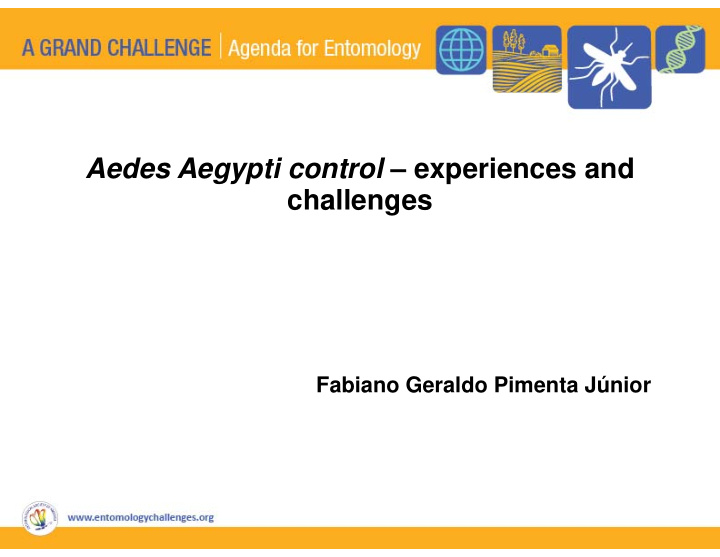



Aedes Aegypti control – experiences and challenges Fabiano Geraldo Pimenta Júnior
Municipality Characteristics Population: 2.502.557 Population density: 7.177 inhabitants/km ² Estimated population in subnormal agglomerates: 292.157
History • 1986 – partnership with Sucam - Aedes albopictus • 1992 – the employment of health agents and the prioritization of the fight against Aedes aegypti • 1994 – decentralization to the areas covered by the health centers • 1999 – Location set for the activities of each field agent • 2007 -2015 – Executive Group for intersectoral actions • 2015 – Public Health Emergency – Civil Defense
Epidemiological situation Casos confirmados de dengue, Belo Horizonte, 1996 a 2016 120,000 100,000 96,121 86,893 80,000 60,000 51,755 40,000 17,192 20,000 12,825 12,911 6,073 5,230 4,578 4,140 3,086 2,310 1,806 1,555 1,581 674 406 585 274 222 68 0 1996 1997 1998 1999 2000 2001 2002 2003 2004 2005 2006 2007 2008 2009 2010 2011 2012 2013 2014 2015 2016
Vector control routines • Coverage: 800.000 properties • 1 field agent for every 725 properties House-to-house visits: 5 visits a year Monitoring strategic points: biweekly Ovitrap monitoring: weekly Transmission blocking Clean-up campaigns – Urban cleaning Forced opening of closed properties
Challenges in the quality of work • Repetitive and tiring work • Low coverage of actions – 20% of the properties are not visited at each cycle • High absenteeism of field agents • Low efficiency of field supervision • Government’s difficulties in providing adequate working conditions – PPE, ladders, vehicles,etc.
Challenges in the quality of work
Structural problems
M easures for greater effectiveness • Variable bonus to field agents linked to process and outcome indicators: placement and removal of ovitraps, vector control at strategic points and incidence of dengue • Definition of priority areas based on the analysis of local data • Integration with Primary Health Care
RISK MAP* FOR OCCURRENCE OF DENGUE IN 2011 BY HEALTH CENTER COVERAGE AREA, B.H./MG, * THE RISK MAP IS BASED ON THE CALCULATION OF COMPOSITE INDICATORS: VECTORS PRESENCE, THE OCCURRENCE OF RECENT CASES, THE IMPLICATIONS IN THE FIRST HALF OF THE PREVIOUS YEAR AND THE TYPE OF PROPERTY OCCUPATION (HORIZONTAL/VERTICAL PROPERTY) THE RISK IS REPRESENTED BY PERCENTILE (THE HIGHER THE PERCENTILE, THE GREATER IS THE RISK)
HOT SPOTS
Local initiatives Analysis of the occurrence of dengue infection vs building verticalization: 1) The risk of being infected by dengue was 3 times higher in horizontal property residents than in vertical property residents; 2) there was no difference in association between dengue infection in residents of apartments above the 1st floor Analysis of 8 surveys = 7.351 positive properties Positive APARTMENTS: 0,9% (69) Main breeding set: flower pots (95%)
Direct operational costs • Field agents (1.379) – US$ 728.950 /month • Higher education professionals - US$ 171.000/month • Vehicles – US$ 153.000/month • Materials - US$ 65.000/month Total Cost – US$ 1.117.950/month 1US$ = R$ 3,80
Challenges in the control of A. aegypti • Limitations of control methods available • Social-environmental vulnerability • Sustainable strategies of population behavior change • The implementation of intersectoral and integrated actions • The issue of employment relationships in the three spheres of government • The control in metropolitan areas: heterogeneity of the activities against the vector among municipalities
25 trucks = US$ 52.000/month Urban Cleaning
Manager Expectations • Less dependence on home visits by the field agents • The possibility to extend the range of visits • Optimization of home visits – productive breeding, better risk prediction • Directing of government actions to specific areas
Manager Expectations • Simpler methods to estimate the population of adult mosquitoes – risk prediction • Simpler methods for adult mosquito control • Continued intersectoral actions with broader and continuous spectrum – collection of waste, continuous water supply • Implementation of operationally and financially viable technologies of wide coverage – infected mosquitoes, genetically modified mosquitoes, irradiated mosquitoes • Additional measures for specific situations – pregnant women
Communication e Mobilization 91% of respondents know how to prevent dengue and how it is transmitted 96% of respondents recall the campaigns against dengue 55% believe they do not take the necessary precautions Poster ? Brochure ? Can entomology be a community mobilization tool? Knowing vs doing
Control of vector transmission of Chagas disease in Brazil • Political priority – decisive role of the academy • Operational viability – decisive role of Entomology • 1943 - 1948 – Studies by Dias & Pellegrino in Bambuí - MG definition of priority criteria to combat the vectors definition of insecticides and their respective dosages operacional research integrated with the service definition of epidemiological and entomological surveillance criteria for native species
Triatomine bugs • > 120 known species • 48 identified in Brazil • 30 were captured in the household environment • 10 are observed in the Amazon region Main genera Triatoma Panstrongylus Rhodnius
Interruption of vectorial transmission of Chagas disease by T. infestans. Brasil, 2006 Certified States, with proven interruption of transmission States without previous transmission
Distribution of Brazilian municipalities according to risk stratification for Chagas Disease - 2006
US$ 17,00 earned for every US$ 1,00 invested in vector control – Akvan, D. – Brasília – OPAS, 1998
The importance of integration: research and service
Recommend
More recommend